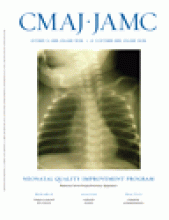Data supplements
Résumé
Incidence and causes of heparin-induced skin lesions
Marc Schindewolf MD, Svantje Schwaner MD, Manfred Wolter MD, Hartmut Kroll MD, Andreas Recke MD, Roland Kaufmann MD, Wolf-Henning Boehncke MD, Edelgard Lindhoff-Last MD, Ralf J. Ludwig MD
Contexte : On connaît peu l’incidence et l’étiologie des lésions cutanées induites par l’héparine. Les deux causes de lésions cutanées induites par l’héparine les plus souvent invoquées sont la thrombocytopénie induite par l’héparine d’origine immunitaire et les réactions d’hypersensibilité retardée.
Méthodes : Nous avons analysé de façon prospective des patients consécutifs ayant reçu de l’héparine par voie sous-cutanée (le plus souvent, énoxaparine ou nadroparine) afin de relever les lésions cutanées induites par l’héparine. En présence de telles lésions, nous avons effectué une biopsie cutanée, mesuré la numération plaquettaire et procédé à un dosage des anticorps dirigés contre le complexe héparine-facteur 4 plaquettaire ainsi qu’à des tests d’allergie.
Résultats : Nous avons recruté 320 patients. En tout, 24 patients (7,5 %, intervalle de confiance IC à 95 %, 4,7 % à 10,6 %) présentaient des lésions cutanées induites par l’héparine. Nous avons retenu la réaction d’hypersensibilité retardée comme élément causal chez les 24 patients. Un patient présentant des signes histopathologiques d’hypersensibilité retardée était porteur d’anticorps dirigés contre le complexe héparine-facteur 4 plaquettaire. Nous avons identifié les facteurs de risque suivants à l’égard des lésions cutanées induites par l’héparine : indice de masse corporelle supérieur à 25 (rapport des cotes RC 4,6; IC à 95 %, 1,7 à 15,3), durée de l’héparinothérapie supérieure à 9 jours (RC 5,9; IC à 95 %, 1,9 à 26,3) et sexe féminin (RC 3,0; IC à 95 %, 1,1 à 8,8).
Interprétation : Les réactions cutanées induites par l’héparine sont relativement courantes. Elles sont associées à des facteurs de risque identifiables et sont couramment causées par une réaction d’hypersensibilité retardée (réponse allergique de type IV). (Registre ClinicalTrials.gov trial n° NCT00510432.)
Affiliations : From the Departments of Internal Medicine, Division of Angiology (Schindewolf, Lindhoff-Last), and Dermatology (Schwaner, Wolter, Kaufmann, Boehncke, Ludwig), Hospital of the Johann Wolfgang Goethe University, Frankfurt am Main, Germany, the DRK-Blooddonorservice (Kroll), Dessau, Germany, and the Department of Dermatology (Recke), University of Lübeck, Lübeck, Germany
Correspondance : Prof. Ralf J. Ludwig, Department of Dermatology; University of Lübeck, Ratzeburger Allee 160, D-23538 Lübeck Germany; fax 49 451 500-2981; sklee{at}mtsinai.on.ca











